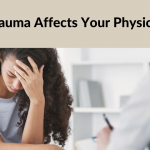Ever felt like a stressful event left you physically drained or unwell? That’s not just in your head – well, not entirely. Emotional trauma can manifest in the body in ways we’re only beginning to understand. From sleep disturbances to chronic pain, the aftermath of trauma can be both wide ranging and deeply personal. In this blog, we’ll explore the complex relationship between emotional trauma and physical health, shedding light on why our bodies respond the way they do and how we can support healing on all fronts.
Emotional Trauma and the Body: More Than Just a Feeling

When we think of trauma, we often focus on the psychological impact – anxiety, depression, flashbacks. But the body holds onto trauma too, in a language of symptoms and sensations. It’s like the mind and the body are in constant communication, and when one is hurting, the other feels it too.
It’s a common misconception that emotional trauma solely affects the mind. In reality, the body acts as a canvas, painting a vivid picture of our internal struggles. When we experience trauma, our bodies become archives, storing memories in the form of physical sensations and reactions. This phenomenon explains why certain smells, sounds, or even touches can trigger a flood of emotions or physical symptoms out of the blue. It’s as if our bodies are trying to tell us the story of our past hurts, longing to be heard and healed. This connection between emotional pain and physical symptoms is a testament to the deep, intricate bond between our mental and physical states. Recognizing this bond is crucial for anyone seeking to understand the full scope of trauma’s impact.
The Science of Stress and Trauma:
The connection between emotional trauma and physical symptoms is not just psychological but also physiological. When faced with stress, our bodies kick into ‘fight or flight’ mode, releasing a cascade of stress hormones like cortisol and adrenaline. This response is crucial for immediate survival, but when the stress is ongoing or the trauma is unresolved, it can lead to chronic health issues.
At the heart of the connection between emotional trauma and physical symptoms lies the body’s stress response system. This system, designed to protect us from immediate danger, can become a source of chronic distress when triggered too often or for too long. When we’re exposed to a traumatic event, our bodies respond by releasing stress hormones like cortisol and adrenaline. This hormonal surge increases heart rate, blood pressure, and energy supplies to prepare us for a quick response. However, when these levels remain elevated due to unresolved trauma, they can wreak havoc on the body, leading to a host of health issues, including heart disease, diabetes, and more. Understanding the physiological basis of the stress response illuminates why addressing both the mind and body is essential in healing from trauma.
Physical Manifestations of Emotional Trauma

The physical symptoms of emotional trauma are as varied as they are complex. For some, chronic pain without a clear medical cause might be a constant reminder of past trauma. For others, gastrointestinal issues like IBS (Irritable Bowel Syndrome) may surface, as the gut is incredibly sensitive to stress. Sleep disturbances, including insomnia and nightmares, are also common, disrupting the body’s need for rest and regeneration. Furthermore, the immune system’s functionality can be compromised, leading to increased vulnerability to infections and illnesses. These manifestations underscore the body’s distress signal, indicating that the emotional wounds of the past are still present and impactful.
Chronic Pain: Unexplained aches and pains can be a physical echo of emotional suffering.
Digestive Issues: Stress and trauma can disrupt gut health, leading to conditions like IBS.
Sleep disturbances: Trouble falling or staying asleep is common among those with unresolved trauma.
Immune System Dysfunction: High stress levels can weaken the immune system, making you more susceptible to illnesses.
Healing the Mind-Body Connection
Understanding the link between emotional trauma and physical symptoms is the first step towards healing. Techniques such as mindfulness, meditation, and trauma-informed therapy can help bridge the gap between mind and body, promoting holistic healing.
Healing from emotional trauma requires an approach that honors the intertwined nature of mind and body. Techniques like mindfulness and meditation can be powerful tools, helping to calm the body’s stress response and fostering a sense of peace and presence. Trauma-informed therapy, particularly approaches like EMDR (Eye Movement Desensitization and Reprocessing) and somatic experiencing, can facilitate the processing of traumatic memories in a safe and controlled manner. By directly engaging with the body’s stored memories of trauma, these therapies can help release the physical manifestations of distress, paving the way for holistic healing.
Supporting Your Body Through Healing

Embarking on a healing journey requires kindness, patience, and practical strategies to support the body. Regular physical activity, tailored to one’s abilities and interests, can significantly reduce symptoms of anxiety and depression, while also strengthening the body’s resilience. Nutritional choices also play a crucial role; a balanced diet can support mood regulation and overall physical health. Finally, establishing a supportive network, whether through therapy, support groups, or connections with loved ones, can provide the emotional sustenance needed for healing. Remember, healing is not a linear process but a journey of rediscovering balance and harmony within oneself.
Mindfulness and Meditation: These practices can help calm the stress response, easing physical symptoms.
Physical Activity: Regular exercise can reduce symptoms of anxiety and depression, and improve physical health.
Seeking Professional Help: A therapist specializing in trauma can offer strategies to cope with both emotional and physical symptoms.
Conclusion:
The impact of emotional trauma on the body serves as a reminder of our integrated nature – that the mind and body are not separate entities but parts of a whole. By acknowledging this connection, we can begin to heal, finding resilience and strength in the process. Remember, healing is not linear, and it’s okay to seek help along the way. Your body has been through a lot; it deserves your kindness and patience.
FAQs:
- Can emotional trauma cause physical illness?
Yes, emotional trauma can contribute to a range of physical illnesses by affecting the body’s stress response and immune system.
- How do I know if my physical symptoms are related to emotional trauma?
If you’re experiencing unexplained physical symptoms alongside emotional distress, it may be worth exploring the possibility of a connection with a healthcare provider.
- What are the first steps to healing from emotional trauma?
Acknowledging the trauma and its impact on your life is the first step. Seeking support from loved ones or a professional can provide the guidance and validation needed for healing.
By understanding the intricate ways in which our bodies respond to emotional trauma, we can embark on a more informed path to recovery and wellbeing. Your journey to healing is deeply personal, and there’s no one size fits all solution, but with the right support and resources, resilience and peace are within reach.
What’s next? Download “The Emotional Healing Workbook.” If you need help getting started, my “Emotional Healing Workbook” will help you navigate through your emotional journey so you can embrace your vulnerabilities and find strength in them.






Leave a Reply